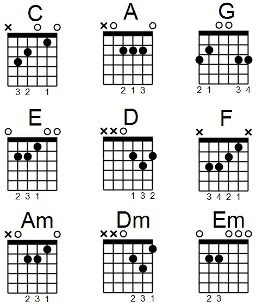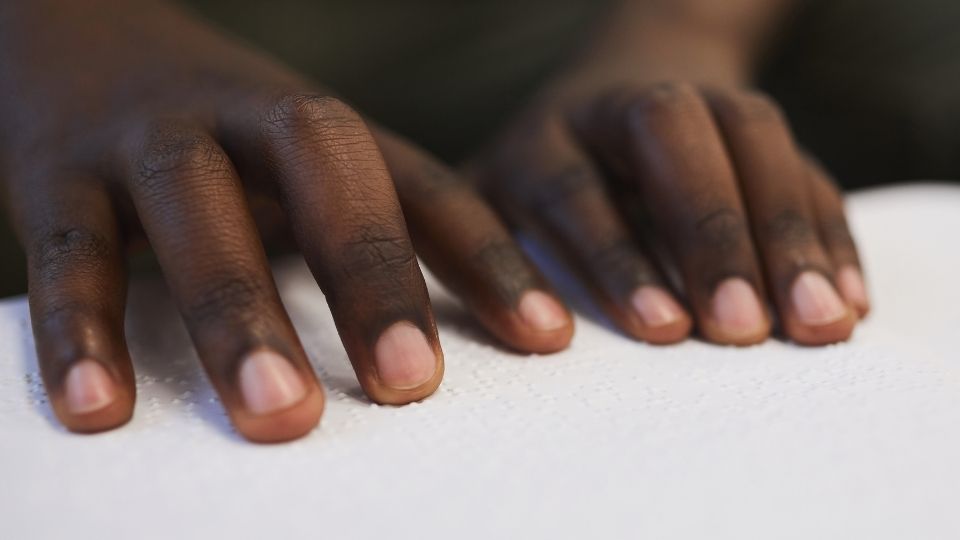By: Sean Dunn & Tim O’Shea
In honor of World Braille Day, Sean Dunn reflects on the connection he finds between braille and music:
I’m a music lover at heart and enjoy playing acoustic guitar every chance I get. Doc Watson and Ray Charles are two of my favorite musicians and I’m fascinated by them when I listen to them play. I’ve always thought of music as a language, and musicians share their voices through their instruments. Over time, I’ve learned that music works more like a code than a language and when these codes are in a particular order, they produce a song.
If you’re familiar with music, you may have heard the term “chord” and how different chords produce different sounds. Each chord is different based on where you place your fingers, and this code translates to different instruments. Playing chords on a guitar reminds me of braille because of the tactile experience of feeling different shapes that represent different sounds or chords. When these shapes are in a coordinated sequence, they can produce a song or phrase.
As I connect the dots between braille, music, and inclusion, I realize that one of the things I love about Integrated Work is that we embrace inclusion and diversity in everything we do. We strive to make our materials more accessible to everyone, giving participants in our activities and events a variety of instruments through which they can find ways to amplify their impact.

Tim O’Shea shares more about World Braille Day and ways to improve accessibility in your activities:
World Braille Day is observed every January 4th and that date marks the birthday of creator Louis Braille, born in Coupvray, France, on January 4, 1809. He became blind following an accident as a child. While attending the National Institute for Blind Youth in Paris, France, Braille yearned for more books to read. Existing methods for creating books for the blind were laborious and the results were difficult to read. Braille experimented with ways to create an alphabet that was easy to read with the fingertips, and at age fifteen he developed the writing system we know today as Braille.[1]
More recently, here in the United States, in January of 2017 final rules were drafted by the government detailing accessibility requirements for information and communication technology. As a government contractor, Integrated Work abides by federal Section 508 Compliance guidelines. We embrace this as an opportunity to further extend our commitment to Justice, Equity, Diversity, and Inclusion (JEDI) principles. Our team is eagerly learning ways to craft and create materials that can be accessed by all. In January of this year, we took part in an accessibility training with TPGi to better understand how to craft accessible documents. We’ve also added real time transcription to our Zoom meetings and convened a working group to continue to explore new methods to welcome and encourage people varying degrees of ability to participate in all that we offer.
We welcome your experiences with accessibility. What are ways you’d like to see your work become more inclusive/accessible in the year ahead?
Tips for more accessible documents[2]:
- Include alternate text for images and visuals. Instead of only relying on your images or graphics to convey information, add a simple description of what is in the media content.
- Add descriptive information for hyperlinks/URLs included in documents. A long URL with lots of characters can be confusing and hard to render through an e-reader. Opt for a simple description such as, “A Link to the Integrated Work blog with more information.”
Leverage a color/contrast checking tool to ensure information is clearly conveyed. We love our brand palette and we’re learning to adjust as needed to assure that information is clearly available and able to be rendered across all screens and readers.

Figure 1: Happy 2022 from Integrated Work!
[1] https://www.afb.org/blindness-and-low-vision/braille/what-braille
[2] https://support.microsoft.com/en-us/office/make-your-word-documents-accessible-to-people-with-disabilities-d9bf3683-87ac-47ea-b91a-78dcacb3c66d
